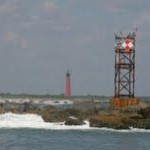How to Make Sense of Charts and Markers on the Fly
from The Fishing Wire
Even small children know what street signs mean. Stop, one-way and the like come easily. But boating traffic aids are different. First of all, the words “map” and “sign” aren’t even part of the lingo when it comes to nautical navigation. Rather, “charts” and “markers” serve as your guides, and it takes some savvy to know how to interpret them without pause.
A compass can be used to locate markers or structures on shore, helping to assure you of your position even without GPSAs long as you are within sight of land and have a chart, you have everything you need to understand your location. In addition to the buoys and such (called navaids in nautical parlance), charts also show significant shoreside structures. All you need to do is look across the top of your compass and read what the bearing (direction to) is to the structure you see on shore. Find the structure on your chart, and draw a line from it on your chart that reflects the bearing you saw. That line represents one leg of your position. Do this with several bits of structure and then plot those bearings on the chart as well, using the compass rose, parallel rules and a pencil. Where all the lines intersect is the point at which you are located. Then look at your depth sounder to see that the water depth matches the depth under the spot where the lines intersect.
You can also use your depth sounder as a navigation tool. Pick a depth contour in the distance offshore that you want to transit (for example 50 feet). If the number goes up, steer toward shore. If it goes down, steer toward the deep. With this simplistic navigation process, even a novice can stay on course. You can readily navigate according to depth contours by simply selecting a depth that more-or-less parallels your course while avoiding obstructions.
So what about using navigation markers? On the Intracoastal Waterways, generally red marks are on the mainland side of the channel. And of course, coming in from sea, it’s always Red/Right/Returning(in the U.S.). Perhaps the easiest way to remember what a mark means is to keep a navaid sticker next to your helm. These helpful stickers can be purchased inexpensively through most marine supply stores. They also give you all the right-
of-way whistle signals.
Don’t be afraid to alter your course and go right up to a marker to see what it is (at slow speed, of course). The absolute best proof of your exact position is to be right next to a marker with a number or letter. Make sure to always check that marker’s position against your chart as well.
Many may think that paper charts are not necessary due to the availability of electronic chart plotters with built-in GPS. But remember two crucial things:
If a device runs on electricity, it can suddenly stop working for numerous reasons no matter how inconvenient the situation. Electronic cartography still has not been deemed a legal means of navigation. If you ever get in an accident due to a navigational error and don’t have that “legal piece of paper” called a government-issued nautical chart, you could find yourself in a difficult situation
Many new boats don’t come equipped with navigation equipment. If you sea-trial a boat in areas where you have no local knowledge, it’s always a good idea to take along a handheld GPS. Alternatively, if you have a smartphone, make sure to download the award-winning Navionics + app. For fishing, try Navionics+ SonarCharts that provide incredible bathymetric charts within the normal chart plotter functions.
With a careful eye and a basic understanding of navigation, you’re ready for a pleasant day on the water.Many states now require boaters to have a certificate proving that you have taken and passed a basic seamanship course. There are numerous such courses to be found online, some at a fee but many are offered free of charge. Boat-ed.com lists all the states that require boating safety certificates and provides links to each.
Finding boating safety courses in your chosen search engine will bring up pages worth of course opportunities. BoatUS® also offers an outstanding free course that can be tailored to various states where you might be boating.
Remember one other important fact: You may live in Virginia and have a certificate from there, but if you travel to Maryland, Delaware or North Carolina, you may need to get certificates from those places as well. Not all contiguous states enjoy boating safety course certification reciprocity. Check first to avoid potential fines.


